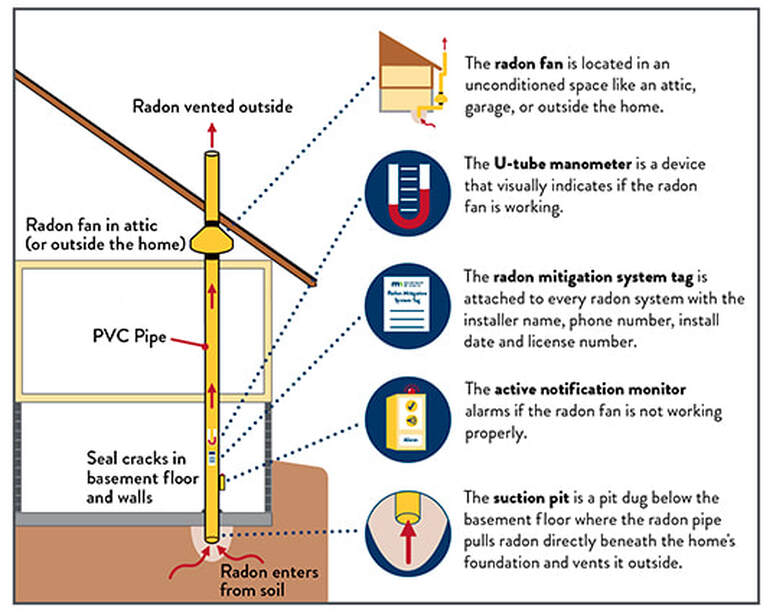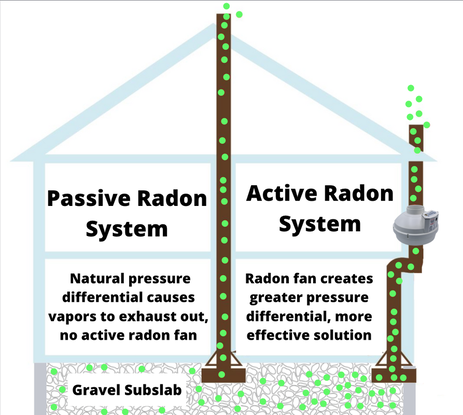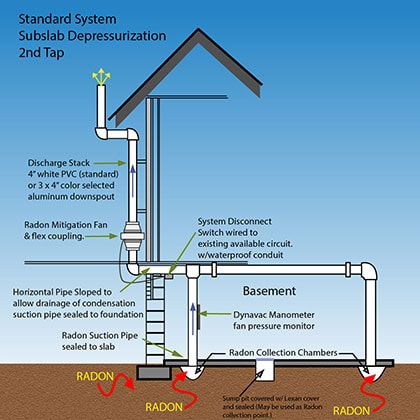Radon
Radon in Homes and Buildings
Radon is an odorless and invisible radioactive gas naturally released from rocks, soil, and water. Radon can get trapped inside homes and buildings and build up in the air. Over time, breathing in high levels of radon can cause lung cancer.
All outdoor and indoor air has some radon in it. Some building materials also can release low levels of radon. Radon can build up in the air in any home or building whether it has a basement, is sealed or drafty, or is new or old. There is no known safe level of radon and you should always aim to have the lowest level. The U.S. Environmental Protection Agency (EPA) recommends fixing your home if radon levels are above 4 picoCuries per liter of air (pCi/L).
The health effects of radon, most notably lung cancer, have been investigated for several decades. Initially, investigations focused on underground miners exposed to high concentrations of radon in their occupational environment. However, in the early 1980s, several surveys of radon concentrations in homes and other buildings were carried out, and the results of these surveys, together with risk estimates based on the studies of mine workers, provided indirect evidence that radon may be an important cause of lung cancer in the general population. Recently, efforts to directly investigate the association between indoor radon and lung cancer have provided convincing evidence of increased lung cancer risk causally associated with radon, even at levels commonly found in buildings. Risk assessments for radon in both mines and residential settings have provided clear insights into the health risks due to radon. Radon is now recognized as the second-leading cause of lung cancer after smoking in the general population. The understanding of radon sources and radon transport mechanisms has evolved over several decades. In the 1950s, high concentrations of radon were observed in domestic and drinking water from drilled wells. Initially, concern about radon in water focused on health effects from ingesting the water. Later, it was determined that the primary health risk of radon in water was from the inhalation of radon released indoors. By the mid-1970s, emanation of radon from building materials was found to be a problem in some areas due to the use of alum shale with enhanced levels of radium.
By 1978, houses were identified in which the indoor radon concentrations were not associated with well-water transport or emanation from building materials. Soil gas infiltration became recognized as the most important source of indoor radon. Other sources, including building materials and well water, are less important in most circumstances.
Epidemiological evidence indicates that indoor radon is responsible for a substantial number of lung cancers in the general population. The distribution of indoor radon in most countries is best represented by a log-normal distribution, with the majority of radon concentrations occurring in the lower range. As a result, most radon-induced lung cancers are thought to occur following exposure to low and moderate radon concentrations. There is now a remarkable coherence between the risk estimates developed from epidemiological studies of miners and residential case-control radon studies. While the miner studies provide a strong basis for evaluating risks from radon exposure and for investigating the effects of modifiers to the dose-response relation, the results of the recent pooled residential studies provide a direct method of estimating risks to people at home without the need for extrapolation from the miner studies.
Radon has little practical use. Some medical treatments have employed radon in small sealed glass tubes, called seeds, that are specially manufactured to contain the exact amount of radioactivity needed for the application. Radon spas are used extensively in Russia and Central Europe to treat a number of conditions.
Radon released from granite building materials can be released over the lifetime of use but typically will be diluted by ventilation. In addition to radon, naturally occurring radioactive elements in the granite can emit small amounts of beta and gamma radiation.
Radon is an odorless and invisible radioactive gas naturally released from rocks, soil, and water. Radon can get trapped inside homes and buildings and build up in the air. Over time, breathing in high levels of radon can cause lung cancer.
All outdoor and indoor air has some radon in it. Some building materials also can release low levels of radon. Radon can build up in the air in any home or building whether it has a basement, is sealed or drafty, or is new or old. There is no known safe level of radon and you should always aim to have the lowest level. The U.S. Environmental Protection Agency (EPA) recommends fixing your home if radon levels are above 4 picoCuries per liter of air (pCi/L).
The health effects of radon, most notably lung cancer, have been investigated for several decades. Initially, investigations focused on underground miners exposed to high concentrations of radon in their occupational environment. However, in the early 1980s, several surveys of radon concentrations in homes and other buildings were carried out, and the results of these surveys, together with risk estimates based on the studies of mine workers, provided indirect evidence that radon may be an important cause of lung cancer in the general population. Recently, efforts to directly investigate the association between indoor radon and lung cancer have provided convincing evidence of increased lung cancer risk causally associated with radon, even at levels commonly found in buildings. Risk assessments for radon in both mines and residential settings have provided clear insights into the health risks due to radon. Radon is now recognized as the second-leading cause of lung cancer after smoking in the general population. The understanding of radon sources and radon transport mechanisms has evolved over several decades. In the 1950s, high concentrations of radon were observed in domestic and drinking water from drilled wells. Initially, concern about radon in water focused on health effects from ingesting the water. Later, it was determined that the primary health risk of radon in water was from the inhalation of radon released indoors. By the mid-1970s, emanation of radon from building materials was found to be a problem in some areas due to the use of alum shale with enhanced levels of radium.
By 1978, houses were identified in which the indoor radon concentrations were not associated with well-water transport or emanation from building materials. Soil gas infiltration became recognized as the most important source of indoor radon. Other sources, including building materials and well water, are less important in most circumstances.
Epidemiological evidence indicates that indoor radon is responsible for a substantial number of lung cancers in the general population. The distribution of indoor radon in most countries is best represented by a log-normal distribution, with the majority of radon concentrations occurring in the lower range. As a result, most radon-induced lung cancers are thought to occur following exposure to low and moderate radon concentrations. There is now a remarkable coherence between the risk estimates developed from epidemiological studies of miners and residential case-control radon studies. While the miner studies provide a strong basis for evaluating risks from radon exposure and for investigating the effects of modifiers to the dose-response relation, the results of the recent pooled residential studies provide a direct method of estimating risks to people at home without the need for extrapolation from the miner studies.
Radon has little practical use. Some medical treatments have employed radon in small sealed glass tubes, called seeds, that are specially manufactured to contain the exact amount of radioactivity needed for the application. Radon spas are used extensively in Russia and Central Europe to treat a number of conditions.
Radon released from granite building materials can be released over the lifetime of use but typically will be diluted by ventilation. In addition to radon, naturally occurring radioactive elements in the granite can emit small amounts of beta and gamma radiation.
Three of the most common types of radon mitigation systems
- Sub-slab suction - Pulls radon directly beneath the home's foundation and vents it outside.
- Drain tile suction - Pipe penetrates into the drain tile and vents the soil gases outside. Covers are placed on the sump baskets.
- Sub-membrane - Used in crawl spaces, a plastic sheet covers exposed dirt on the floor, extends up onto the wall and is sealed. A radon pipe penetrates the plastic sheeting, pulls the soil gas from the crawl space, and vents it outside.
Find Additional Information at These Websites
This Old House.com "How To Install A Radon Mitigation System
Environmental Protection Agency EPA - Radon
Environmental Protection Agency EPA - How To Protect Your Family From Radon When Buying A Newly Built Home
Environmental Protection Agency EPA - Building A New Home? Have You Considered Radon?
Environmental Protection Agency EPA - Radon and Real Estate Resources
Environmental Protection Agency EPA - Radon Resistant Construction Basics and Techniques
Environmental Protection Agency EPA - Builder and Contractor Resources "Radon Resistant New Construction
Environmental Protection Agency EPA - Radon Standards Of Practice
This section is not a comprehensive and total explanation of radon, but answers many of the common questions and provides sites to get that information. You are encouraged to ask questions of Radon Mitigation Contractors who are the the experts in the field.



